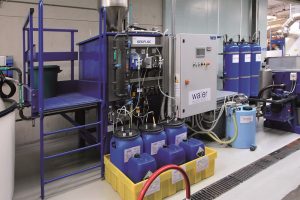An industry 4.0-oriented chemical-physical plant for the treatment and purification of waste water from galvanic processes
Athena, a well-established company specialising in engine components, has developed a unique nickel plating treatment without losing sight of the importance of limiting the anthropogenic impact normally entailed by this kind of operations. This is why it turned to Water Energy to find the most sustainable and innovative plant solution for the treatment and purification of waste water from galvanic processes. The choice fell on an Industry 4.0-oriented chemical-physical plant which improves the environmental impact, the productivity and the quality of wastewater treatment.
The system installed at Athena’s factory consists of two tanks. At the entrance to the first one, acid coagulant is added to make any necessary corrections of the pH value, in order to both promote the formation and precipitation of flakes and comply with the legal parameters for the discharge of waste water. In addition to the acid coagulant, an absorbent material is added through a hopper that contributes to the formation of flakes. When the fluid reaches the second tank, flocculant is added. The plant ends with a sedimentation tank. Sludge has a greater density than water and therefore it tends to precipitate to the bottom of the container. A few blades clean the walls of the sedimentation tank by conveying the removed sludge to its bottom. Purified from chlorides and heavy metals, water precipitates and it is collected in a storage tank. During the clean water precipitation phase, the compliance of its pH value is checked with legal requirements and the absence of any residues of suspended material through a turbidimeter. The continuous control of parameters and the technical measures implemented to ensure constant water quality ensure class A water is produced: in conditions of hydrogeological balance, this process’ anthropic impact is null or negligible, in addition to meeting all the parameters for the discharge of surface water.
These controls on both the pH value and water turbidity are carried out continuously. If the latter is not optimal, the system sends the liquid back to the beginning through a solenoid valve in order repeat the waste water treatment cycle, while reporting the issue to the plant manager. Athena can perform these checks thanks to the connection of the Water Energy system with its company network, which allows its remote management. In case of problems, the company can interface promptly with Water Energy’s staff, who modifies the parameters so that the system is always able to meet the chemical-physical needs of the processes.
Read the full article published on ipcm n. 66: https://www.ipcm.it/en/open/ipcm/2020/66/122-130.aspx

